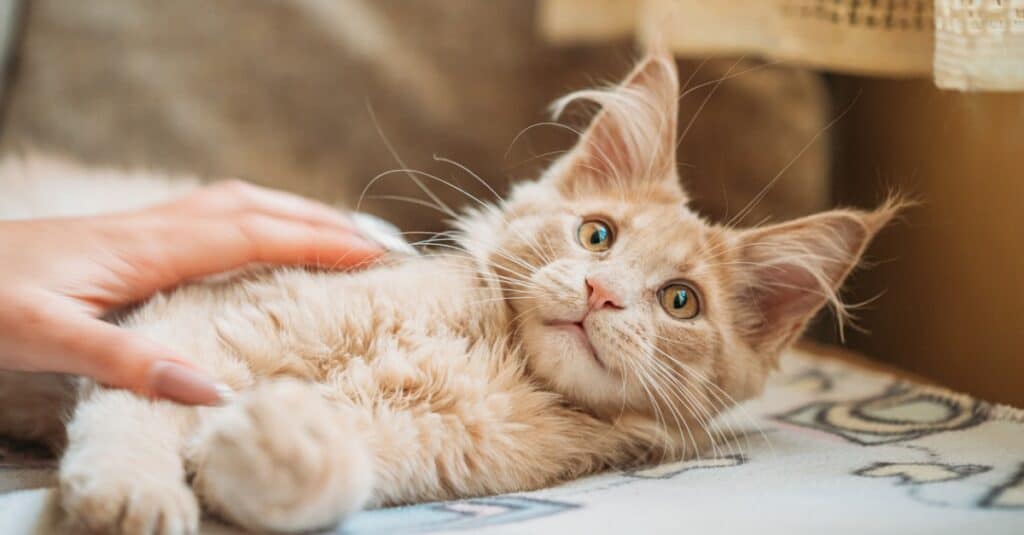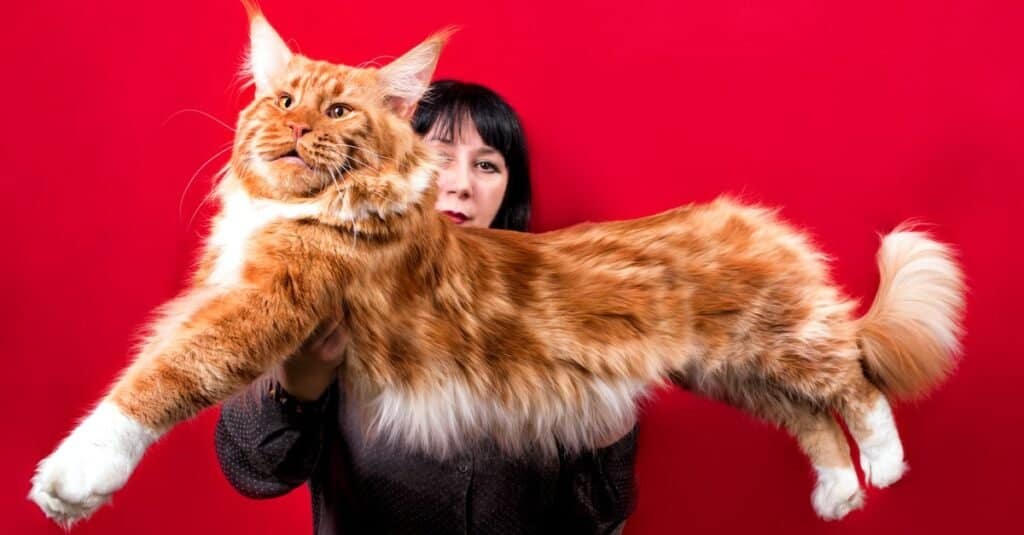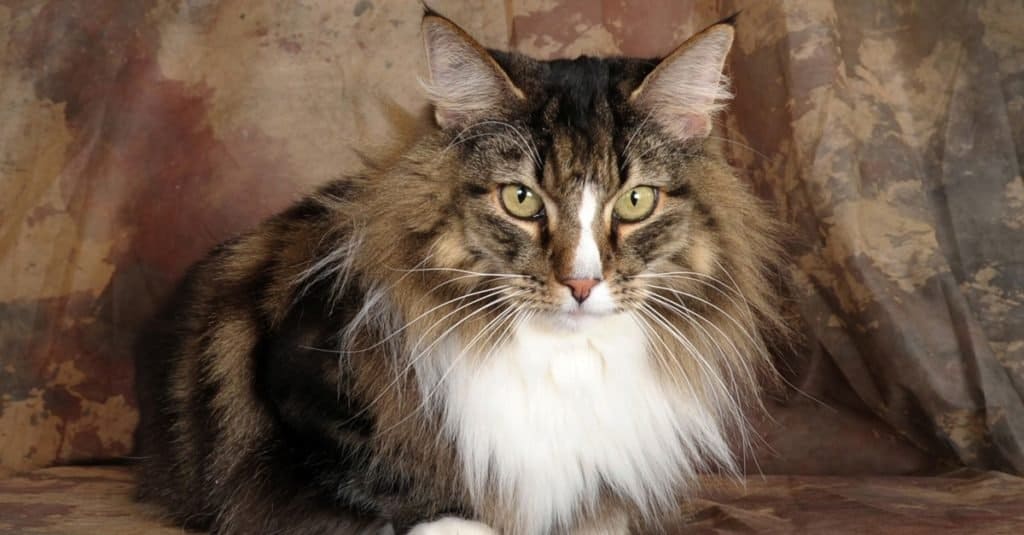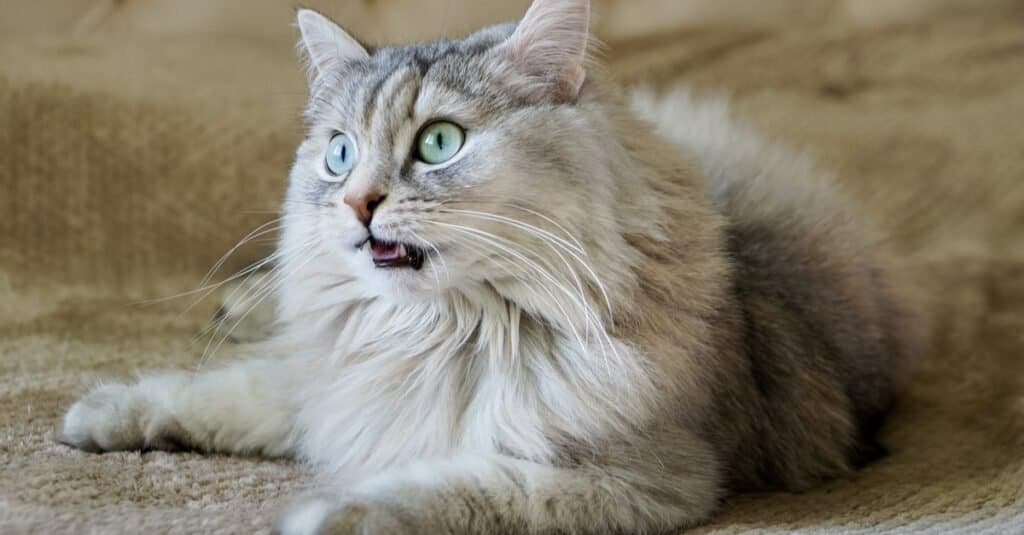Maine Coons and Norwegian Forest cats are both large, long-haired species of house cat. It’s easy to confuse these similar felines.
Neither are fully grown until around sometimes 5 years old due to their ginormous size, though Maine Coons may reach their full size as soon as 3 years old. Both cats have distinctive tufts of fur on their ears as well as between the toes on their feet.
These long-haired cats have similar grooming requirements; namely, a daily combing to avoid painful mats in their fur. However, Maine Coons require more attention.
The easiest way to tell these cats apart is to look at their faces. While Maine Coons are a bit boxy in appearance, Norwegian Forest cats have a slimmer, more angular face shape.
In this article, we’ll discuss all of the differences between Maine Coons and Norwegian Forest cats so that you can learn to tell these breeds apart!
Maine Coon vs Norwegian Forest Cat

An identifying feature of the Maine Coon is its boxy-shaped head.
©Grisha Bruev/Shutterstock.com
Each of these cats is known for their intelligence, laid-back dispositions, and long coats. Someone without knowledge of the breeds could easily confuse them, but they’re quite easy to tell apart once you know what you’re looking for.
Here are some of the most distinctive differences:
| Maine Coon | Norwegian Forest Cat | |
| Energy Level | High | Low |
| Head | Boxy, with a snout extending outward starting between the eyes | Flat snout extending from the top of the head |
| Eyes | Oval | Round |
| Body | Large and muscular; legs are all similar in length | Large and muscular; back legs are taller than front legs |
| Fur | Long-haired, with longer fur on belly, hind end, and neck | Even, long coat |
| Origin | Maine | Scandinavia |
The 6 Key Differences Between Norwegian Forest Cats and Maine Coons
1. Maine Coons Are High-Energy Cats

The Maine Coon is a good breed for those looking for a higher energy cat.
©Sergey Ginak/Shutterstock.com
Maine Coons are known for their high energy levels and intense loyalty to their people. Owners of Maine Coons say that they could play all day long!
Some even refer to them as “dog-like,” however this term should be discouraged because it shows a lack of understanding of cats — namely, that any feline breed needs exercise, training, and attention!
While cats do communicate differently than dogs, they are still incredibly social animals that have evolved to depend on humans for survival.
Regardless, Maine Coons are a great breed for those who would like a higher-energy cat, or even one who likes to go on walks!
Keep in mind that harness training takes time, and some cats just don’t take to it. While we can make some generalizations based on breed, they won’t always apply because each cat has their own unique personality.
Norwegian Forest cats tend to sit at the other end of the energy spectrum. They can be seen as couch potatoes, preferring a good nap to an intense play session.
All cats do need play, however, and it’s especially important to entice your Norwegian to get up, exercise, and stay fit!
Cats of any breed should get at least 30-45 minutes of daily play, broken into 10-15 minute sessions throughout the day.
They might not race around this entire time, but instead focus on the toy for long periods — this is perfectly normal, as it’s how cats hunt in the wild. Stimulating their minds in this way is equally as important as physical exercise.
The difference between these breeds is that a Norwegian Forest cat is more likely to be done after 10 minutes of play or spend more time passively “stalking” the toy, while a Maine Coon will play more intensely and might even want to keep going past the 15 minute mark!
2. Norwegian Forest Cats Have Flat Snouts and Triangular Heads

Norwegian forest cats have a more triangular face shape.
©GracefulFoto/Shutterstock.com
Physical traits are the most reliable way to tell these cats apart. One simple one is their face and head shape.
Norwegian Forest cats have snouts that come down from their head in a singular line, while the Maine Coon’s snout curves outward near their eyes.
Maine Coons have boxy features, while Norwegian Forest cats have a more triangular face shape.
Both have big ears, often with fur tufts, but the Maine Coon’s sit higher on their head. This gives the ears a more upright appearance, while the lower-set ears of the Norwegian Forest cat make them appear to come off of the face at an angle.
3. Maine Coons Have Varied Fur Length

The Norwegian Forest cat has an even-length coat that requires daily combing.
©Elisa Putti/Shutterstock.com
Maine Coons have long coats that grow longer around the mane, stomach, and butt areas. Norwegian Forest cats have even-length coats all over their bodies.
Both of these cats require a daily combing to keep them free of mats. Once the fur begins to tangle and mat, it will pull painfully against their skin — especially around the armpits (where its foreleg meets its body, under the junction of its arm and shoulder) and hips as the cat moves.
If your cat does become matted, it’s best to contact a professional cat groomer, and not someone who works only with dogs. Mats often develop very close to your cat’s skin, which will stretch away from their body if you tug the mat forward — making it incredibly easy to cut the skin without meaning to.
4. Norwegian Forest Cats Have Rounder Eyes
Norwegian Forest cats have round eyes, while Maine Coons have oval-shaped eyes. If a Maine Coon widens their eyes they might appear more rounded, but this isn’t typically their shape while rested.
5. They Originate in Different Parts of the World

Vikings are believed to have brought the Maine Coon to the U.S.
©iStock.com/Iuliia Komarova
The Norwegian Forest cat is an older breed, originating in Scandinavia. Their thick, double coat helped them get through harsh winters.
Many myths surround the origin of the Maine Coon. Some say a racoon and a cat fell in love and had offspring. While the markings of the cat make this almost believable, this is a tall tale for sure. Another idea is that Marie Antoinette bred the cats and shipped them ahead of her in her attempt to flee France with her beloved fur babies. Or, perhaps these long-haired, gentle giants were brought over by Vikings. This theory is the most plausible.
However they arrived, Maine Coons originated in Maine, and are possibly a descendant of the Norwegian Forest cat! They are the official cat of Maine.
6. Norwegian Forest Cats Have Longer Hind Legs
Lastly, Maine Coons have legs of an even length, like most house cats. Norwegian Forest cats have slightly longer hind legs than front legs.
How Long Do Maine Coons Live?
Maine Coons have an average lifespan of 12.5 years and can live 9-13 years. Some long-time owners of this breed reporting that their Maine Coons have lived past 20 years of age. A few of the issues that can impact their health are arthritis, dental health issues, kidney problems, and cancer.
The oldest Maine Coon known was Rubble, who was aged 31 years old when he died in July 2020 in Exeter, England. He was also possibly the oldest living cat in the world! Read more of his story here.
How Long Do Norwegian Forest Cats Live?
Norwegian Forest Cats generally live between 14 and 16 years. They have a genetic predisposition to heart and kidney diseases and this can affect their health and lifespan. Glycogen storage disease type IV is more common in Norwegian Forest Cats than in the average cat, and is lethal but very rare.
Are Norwegian Forest Cats Mythological?
In Norse mythology, Norwegian forest cats, or skogkatts, played an important role, being the animal of choice to pull the enchanted chariot of Freya, the Norse goddess of fertility, beauty, and love. Her forest cats, called mountain-dwelling fairy cats, were epically large, said to be too heavy for even the strongest gods like Thor to lift.
Norwegians believed Freya to be very fond of her cats, so farmers would leave bottles of milk in their fields for the cats to drink, just in case they passed through. They thought that this good deed would bring them a rich harvest. Another belief they harbored was that girls who loved cats would be luckier in love, as Freya was also the goddess of love. In other words, their culture smiled on “cat ladies.”
Maine Coon vs Ragamuffin

The ragamuffin is another breed that’s similar to the Maine Coon.
©Trusova Evgeniya/Shutterstock.com
Another breed that the Maine Coon is often confused with is the Ragamuffin. Both are similar large and fluffy breeds, with the main differences between the two being breed origin, size, and temperament.
Ragamuffins are a relatively newer cat breed that developed when a group of Cherubim Ragdoll breeders broke away from the Ragdoll breed to form their own group, with Ragamuffins being officially recognized as distinct in 1994. Maine Coons have a much longer lineage and are considered one of the oldest North American breeds, being first bred in Maine likely around the 18th century.
While the Ragamuffin is a large cat breed, with many reaching 10-15 pounds, the Maine Coon is the biggest non-hybrid breed around and can grow 13-18 pounds on average, with some even larger.
Both breeds make a great companion cat. Ragamuffins are typically docile, friendly, sweet, and cuddly, and do well in apartments and homes where there are multiple people living. Maine Coons are gentle giants, intelligent, relaxed, and vocal. Check out a detailed comparison between these two breeds here.
The photo featured at the top of this post is ©
Thank you for reading! Have some feedback for us? Contact the AZ Animals editorial team.






